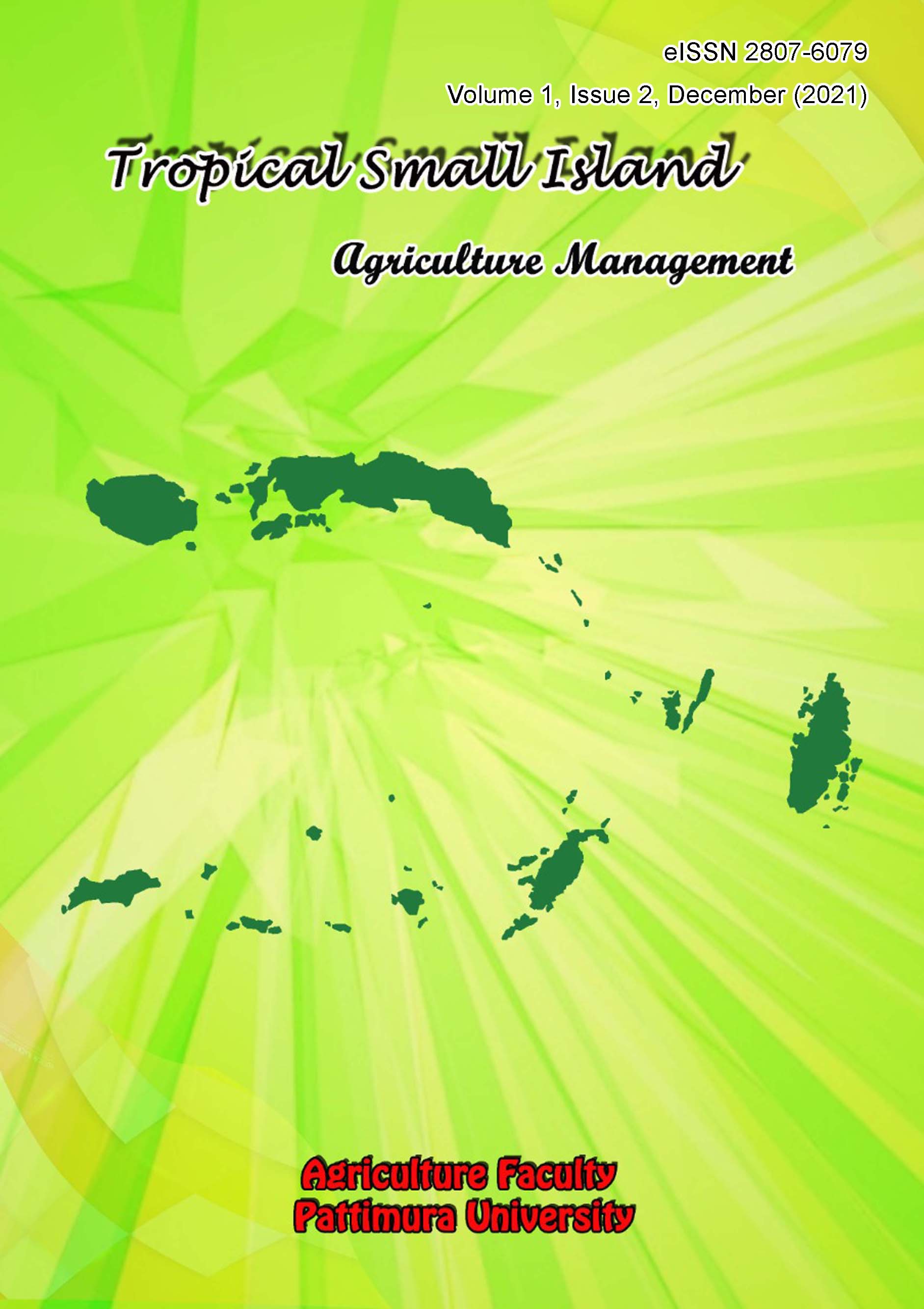Respon Tanaman Selada (Lactuca sativa L.) Terhadap Pemberian Pupuk Organik Urine Kambing
Response of Lettuce Plant (Lactuca sativa L.) To The Application of Organic Fertilizer of Goat Urine
Abstract
This study aims to determine the response of lettuce plants to the application of goat urine organic fertilizer. The study was a Complete Randomized Design with 1 factor 4 repeats. The results showed that the concentration of goat urine organic fertilizer showed that K4 treatment (200 mL concentration) on the parameters of plant height (cm), number of leaves (strands), leaf area (cm2), fresh weight of plants (g), fresh weight of roots (g), and harvest index gave the highest yield on lettuce plants followed by other treatments such as K5 (Concentration 250 mL), K6 (Concentration 300 mL), K7 (Concentration 350 mL), K3 (Concentration 150 mL), K2 (Concentration 100 mL), K1 (Concentration 50 mL) and the lowest of the parameters above corresponds to K0 (without control). The concentration of organic fertilizer from goat urine significantly influences the K4 treatment. This shows that this concentration can provide the nutrients needed to support optimal vegetative growth of lettuce plants.
Downloads
References
Balai Penelitian Ternak. (2003). Kotoran kambing-domba pun bisa bernilai ekonomis. Warta Penelitian dan Pengembangan Pertanian Indonesia, 25(5), 16-18.
Gardner, F.P., Pearce, R.B. & Mitchell, R.L. (1991). Fisiologi Tanaman Budidaya. Terjemahan Herawati Susilo. UI Press. Jakarta.
Haryanto, E., Suhartini, T., & Rahayu, E. (2006). Sawi dan Selada. Penebar Swadaya. Jakarta.
Makaruku, M.H. 2015. Respon pertumbuhan tanaman selada (Lactuca sativa L.) terhadap pmberian pupuk organik. Jurnal Agroforestri, 10(3), 239-246.
Manullang, G.S., Rahmi, A. & Astuti, P. (2014). Pengaruh jenis dan konsentrasi pupuk organik cair terhadap pertumbuhan dan hasiltanaman sawi (Brassica juncea L.) varietas tosakan. Agrifor: Jurnal Ilmu Pertanian dan Kehutanan, 13(1), 33-40. http://ejurnal.untag-smd.ac.id/index.php/AG/article/view/545
Pardosi, A.H., Irianto, & Mukhsin. (2014). Respons Tanaman Sawi Terhadap Pupuk Organik Cair Limbah Sayuran Pada Lahan Kering Ultisol. Dalam Prosiding Seminar Nasional Lahan Suboptimal, Palembang, 26 - 27 September 2014. 77-83.
Pradita, N. & Koesriharti (2019). Pengaruh pupuk organik cair terhadap pertumbuhan dan hasil tiga varietas selada (Lactuca sativa L.) pada sistem NFT. Jurnal Produksi Tanaman, 7(4), 706–712. https://protan.studentjournal.ub.ac.id/index.php/protan/article/view/1107
Sarah., Rahmatan, H. & Supriatno. (2016). Pengaruh pemberian berbagai konsentrasi urine kambing yang difermentasi terhadap pertumbuhan vegetatif lada (Piper nigrum L.). Jurnal Ilmiah Mahasiswa Pendidikan Biologi, 1(1), 1-9. https://jim.usk.ac.id/pendidikan-biologi/article/view/375.
Samadi, B. (2014). Rahasia Budidaya Wortel Sistem Organik. Pustaka Mina: Depok.
Sitompul, S.M. & Guritno, B. (1995). Analisis Pertumbuhan Tanaman. UGM Press. Yogyakarta.
Titiaryanti, N.M., Setyorini, T., & Sormin, S.Y.M. (2018). Pertumbuhan dan hasil Selada pada berbagai komposisi media tanam dengan pemberian urin kambing. AGROISTA: Journal Agroteknologi, 2(1), 20-27. https://jurnal.instiperjogja.ac.id/index.php/AGI/article/view/24
Wardhana, I., Hasbi, H., & Wijaya, I. (2016). Respons pertumbuhan dan produksi tanaman selada (Lactuca sativa l.) pada pemberian dosis pupuk kandang kambing dan interval waktu aplikasi pupuk cair super bionik. Agritrop: Jurnal Ilmu-Ilmu Pertanian, 14(2), 165-185. http://jurnal.unmuhjember.ac.id/index.php/AGRITROP/article/view/431
Copyright (c) 2023 The Author(s)

This work is licensed under a Creative Commons Attribution-ShareAlike 4.0 International License.
Authors who publish with this journal agree to the following terms:
- Authors retain copyright and grant the journal right of first publication with the work simultaneously licensed under a Creative Commons Attribution License that allows others to share the work with an acknowledgment of the work's authorship and initial publication in this journal.
- Authors are able to enter into separate, additional contractual arrangements for the non-exclusive distribution of the journal's published version of the work (e.g., post it to an institutional repository or publish it in a book), with an acknowledgment of its initial publication in this journal.
- Authors are permitted and encouraged to post their work online (e.g., in institutional repositories or on their website) prior to and during the submission process, as it can lead to productive exchanges, as well as earlier and greater citation of published work (See The Effect of Open Access).









